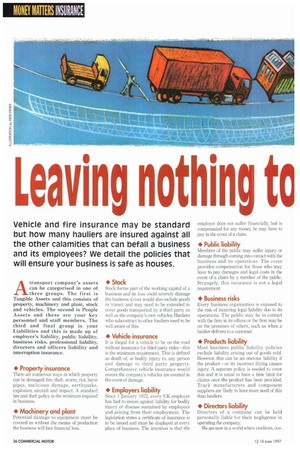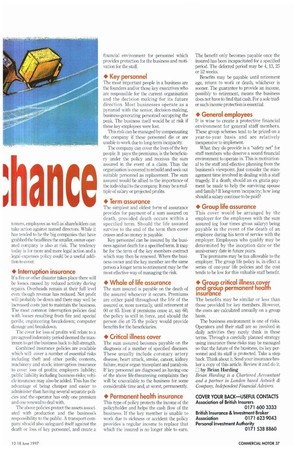heaving nothin
Page 48

Page 49

If you've noticed an error in this article please click here to report it so we can fix it.
Vehicle and fire insurance may be standard but how many hauliers are insured against all the other calamities that can befall a business and its employees? We detail the policies that will ensure your business is safe as houses.
Atransport company's assets can be categorised in one of three groups. The first is Tangible Assets and this consists of property, machinery and plant, stock and vehicles. The second is People Assets and these are your key personnel and staff members. The third and final group is your Liabilities and this is made up of employer's liability, public liability, business risks, professional liability, directors and officers liability and interruption insurance.
• Property insurance
There are numerous ways in which property can be damaged; fire, theft, storm, riot, burst pipes, malicious damage, earthquake, explosion, aircraft and impact. A standard fire and theft policy is the minimum required in business,
• Machinery and plant
Potential damage to equipment must be covered as without the means of production the business will face financial loss.
• Stock
Stock forms part of the working capital of a business and its loss could severely damage the business. Cover would also include goods in transit and may need to be extended to cover goods transported by a third party as well as the company's own vehicles. Hauliers who subcontract to other hauliers need to be well aware of this.
• Vehicle insurance
It is illegal for a vehicle to be on the road without insurance for third party risks this is the minimum requirement. This is defined as death of, or bodily injury to, any person and damage to third party property. Comprehensive vehicle insurance would ensure the company's vehicles are covered in the event of damage.
• Employers liability
Since January 1972, every UK employer has had to insure against liability for bodily injury or disease sustained by employees and arising from their employment. The legislation states a certificate of insurance is to be issued and must be displayed at every place of business. The intention is that the employer does not suffer financially, but is compensated for any money he may have to pay in the event of a claim.
• Public liability
Members of the public may suffer injury or damage through coming into contact with the business and its operations. The cover provides compensation for those who may have to pay damages and legal costs in the event of a claim by a member of the public. Strangely, this insurance is not a legal requirement
• Business risks
Every business organisation is exposed to the risk of incurring legal liability due to its operations. The public may be in contact with the firm in its offices or the firm may be on the premises of others, such as when a haulier delivers to a customer.
• Products liability
Most business public liability policies exclude liability arising out of goods sold. However, this can be an onerous liability if the product—or its incorrect fitting causes injury A separate policy is needed to cover this and it is usual to have a time limit for claims once the product has been provided. Truck manufacturers and component suppliers are likely to have more need of this than hauliers.
• Directors liability
Directors of a company can be held personally liable for their negligence in operating the company.
We are now in a world where creditors, cus turners, employees as well as shareholders can take action against named directors. While it has tended to be the big companies that have grabbed the headlines the smaller, owner-operated company is also at risk. The tendency today is for more and more legal action and a legal expenses policy could be a useful addition to cover.
• Interruption insurance If a fire or other disaster takes place there will be losses caused by reduced activity during repairs. Overheads remain at their full level even though revenue has reduced. Net profit will pmbably be down and there may well be increased costs just to maintain the business. The most common interruption policies deal with losses resulting from fire and special perils; engineering breakdown; computer damage and breakdown.
The cover for loss of profits will relate to a pre-agreed indemnity period deemed the maximum to get the business back to full strength.
Combined insurance policies are available which will cover a number of essential risks including theft and other perils; contents, machinery and stock; interruption insurance to cover loss of profits; employers liability; public liability including business risks; vehicle insurance may also be added. This has the advantage of being cheaper and easier to administer than having several separate policies and the operator has only one premium and one renewal to deal with.
The above policies protect the assets associated with production and the business's responsibility to the public. A transport company should also safeguard itself against the death or loss of key personnel, and create a financial environment for personnel which provides protection for the business and motivation for the staff.
• Key personnel
The most important people in a business are the founders and/or those key executives who are responsible for the current organisation and the decision making for its future direction. Most businesses operate as a pyramid with the senior, decision-making, business-generating personnel occupying the peak. The business itself would be at risk if these key employees were lost.
This risk can be managed by compensating the company if these personnel die or are unable to work due to long-term incapacity The company can cover the lives of the key people. It pays the premiums, is the beneficiary under the policy and receives the sum assured in the event of a claim. Thus the organisation is covered to rebuild and seek out suitable personnel as replacement. The sum assured would be allied to the importance of the individual to the company. It may be a multiple of salary or projected profits.
• Term assurance
The simplest and oldest form of assurance provides for payment of a sum assured on death, provided death occurs within a specified term. Should the life assured survive to the end of the term then cover ceases and no money is payable.
Key personnel can be insured by the business against death for a specified term. It may be for the terni of the key members contract which may then be renewed. Where the business owner and the key member are the same person a longer term to retirement may be the most effective way of managing the risk.
• Whole of life assurance
The sum assured is payable on the death of the assured whenever it occurs. Premiums are either paid throughout the life of the assured or, more normally, until retirement at 60 or 65. Even if premiums cease at, say 60, the policy is still in force, and should the person die at 75 the policy would provide benefits for the beneficiaries.
• Critical illness cover
The sum assured becomes payable on the diagnosis of a number of specified diseases. These usually include coronary artery disease, heart attack, stroke, cancer, kidney failure, major organ transplant and paralysis. If key personnel are diagnosed as having one of the above life-threatening complaints they will be unavailable to the business for some considerable time and, at worst, permanently
• Permanent health insurance
This type of policy protects the income of the policyholder and helps the cash flow of the business. If the key member is unable to work due to sickness or accident the policy provides a regular income to replace that which the insured is no longer able to earn.
The benefit only becomes payable once the insured has been incapacitated for a specified period. The deferred period may be 4, 13, 25 or 52 weeks.
Benefits may be payable until retirement age, return to work or death, whichever is sooner. The guarantee to provide an income, possibly to retirement, means the business does not have to find that cash. For a sole trader such income protection is essential.
• General employees
It is wise to create a protective financial environment for general staff members. These group schemes tend to be priced on a year-to-year basis and are relatively inexpensive to implement What they do provide is a "safety net" for staff members who deserve a sound financial environment to operate in. This is motivational to the staff and effective planning from the business's viewpoint. Just consider the management time involved in dealing with a staff tragedy. If a death; should an ex gratia payment be made to help the surviving spouse and family? If long-term incapacity; how long should a salary continue to be paid?
• Group life assurance
This cover would be arranged by the employer for the employees with the sum assured (eg four times gross salary) being payable in the event of the death of an employee during his term of service with the employer. Employees who qualify may be determined by the inception date or the anniversary date in future years.
The premiums may be tax allowable to the employer. The group life policy is, in effect a series of one-year life policies and the cost tends to be low for this valuable staff benefit
• Group critical illness cover pnd group permanent health insurance
The benefits may be similar or less than those provided for key members. However, the costs are calculated annually on a group basis.
The business environment is one of risks. Operators and their staff are so involved in daily activities they rarely think in these terms. Through a carefully planned strategy using insurance these risks may be managed SO that the future of the business, its key personnel and its staff is protected. Take a step back. Think about it. Send your insurance broker a copy of this article. Review it and do it. CI by Brian Harding Brian Harding is a Chartered Accountant and a partner in London based Astwick & Company, Independent Financial Advisers
COVER YOUR BACK—USEFUL CONTACTS Association of British Insurers 0171 600 3333 British Insurance & Investment Broker
Association 0171 623 9043 Personal Investment Authority
























































































































